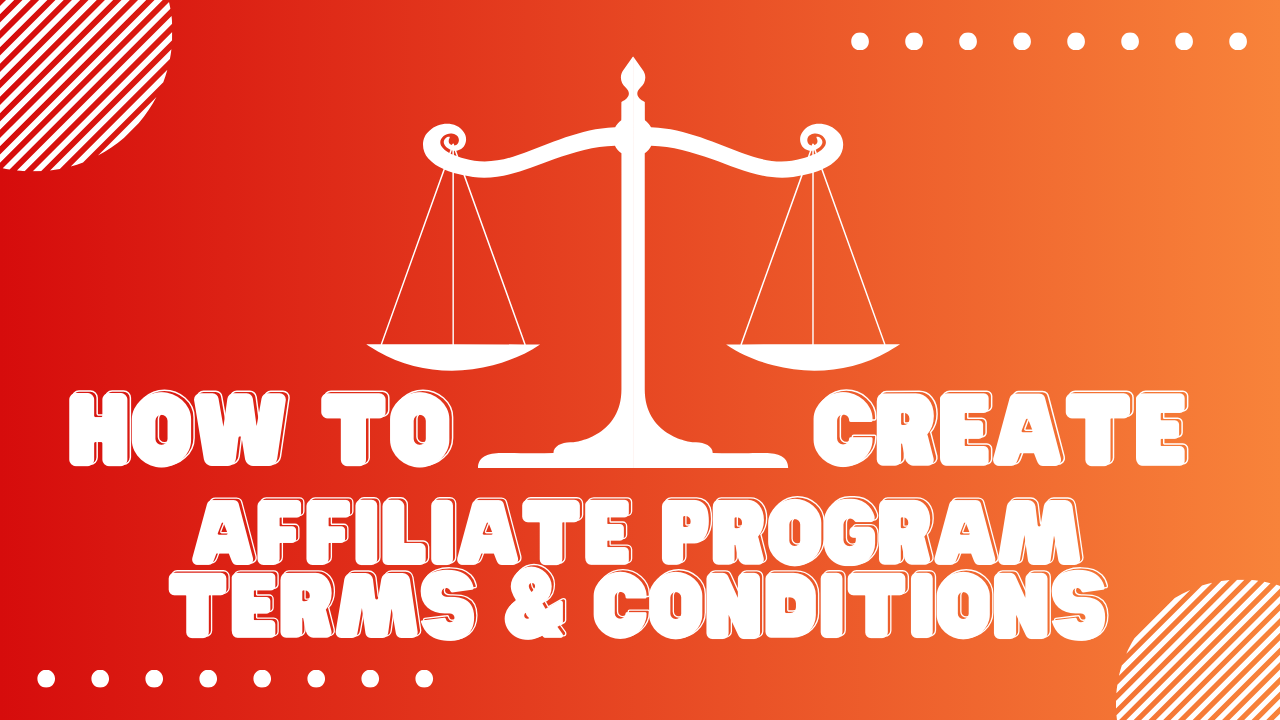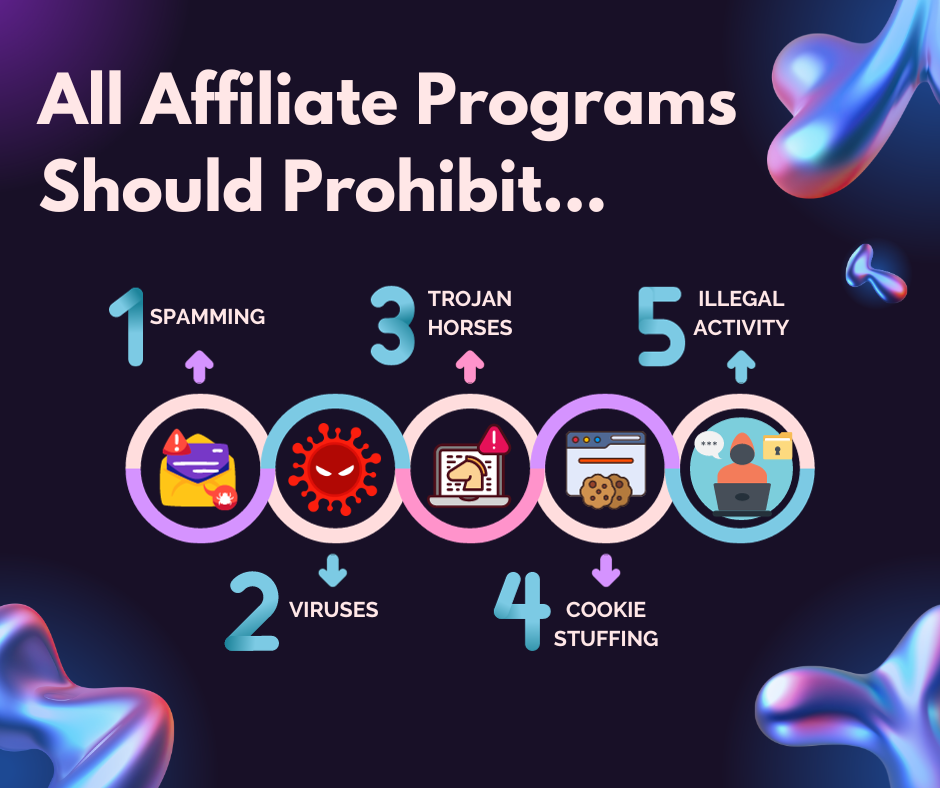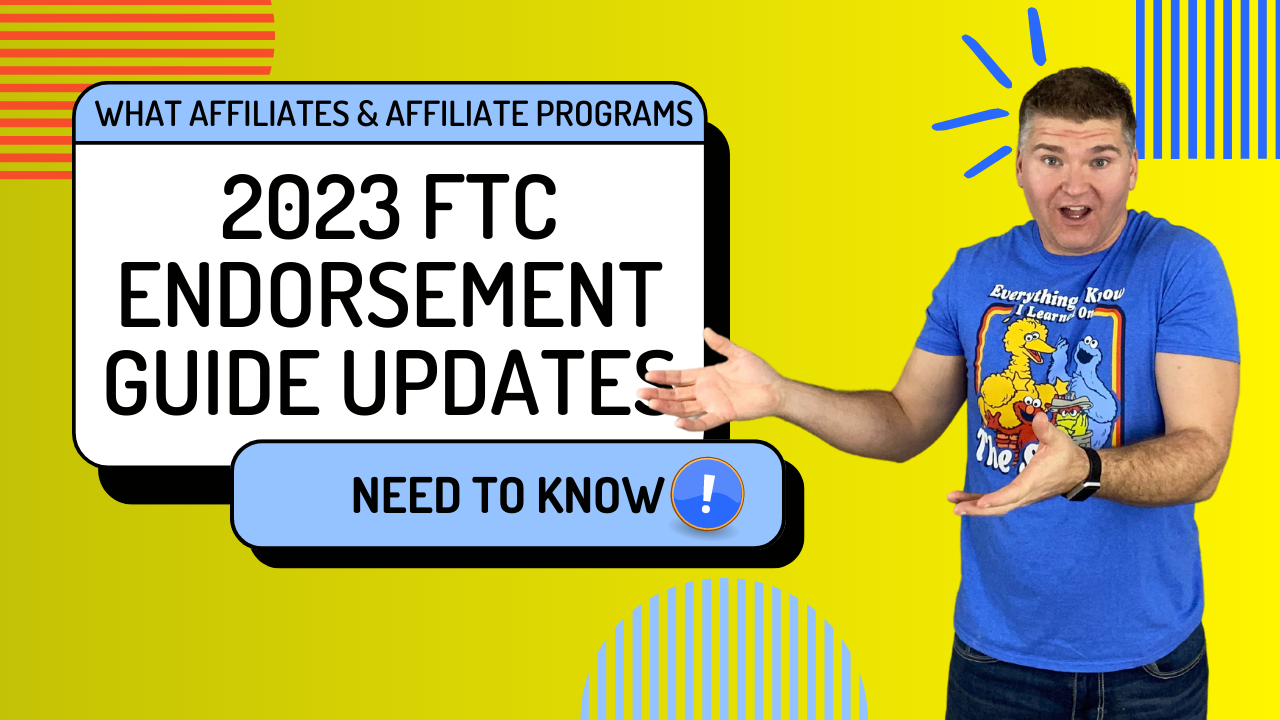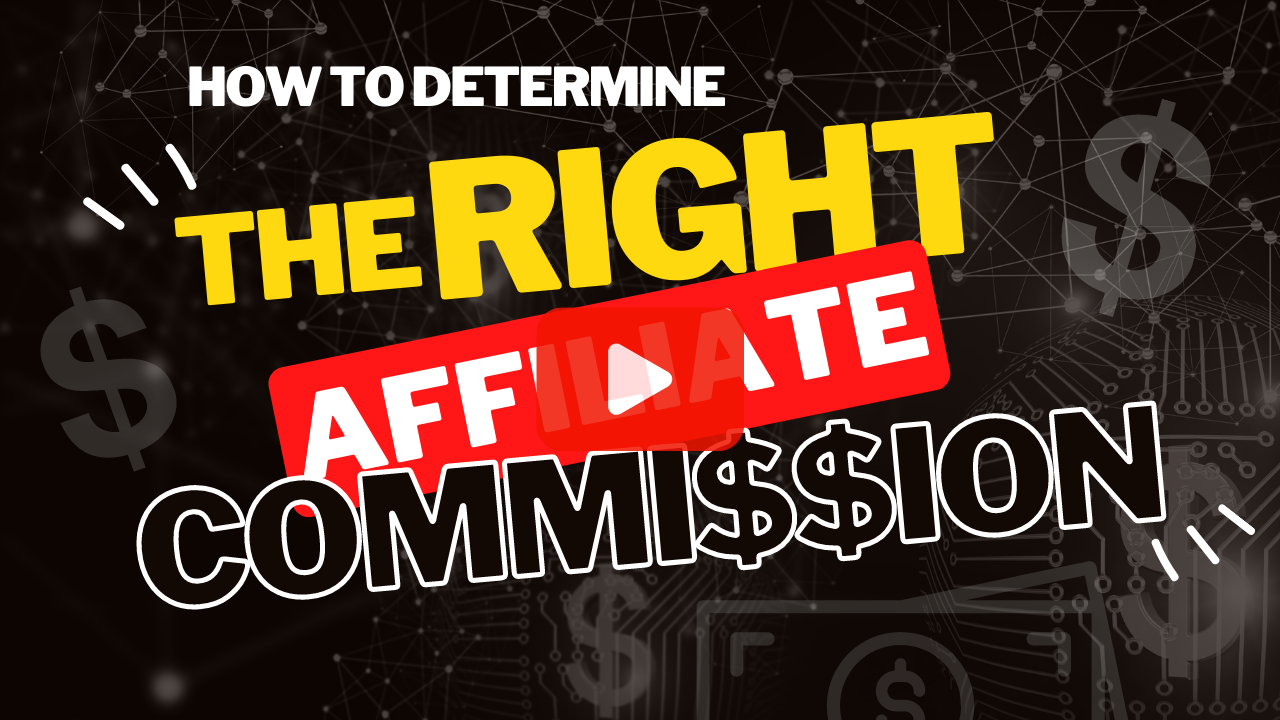Looking to create an affiliate program agreement (AKA terms and conditions)? You’ve landed in the perfect spot. In this article, we’ll dive deep into the art and science of establishing legally sound contracts for your affiliate program. I’m going to walk you through the exact process I’ve used to develop terms and conditions for some of the top affiliate programs in the world such as Shutterfly, Adidas, and many more. And here’s the best part: You don’t need to be a legal expert to navigate this. I’m going to break it down into simple, easy-to-understand steps to make it easy to create your affiliate program’s terms and conditions.

But, first…before we get into how to create your affiliate terms and conditions, I have to say this (no, really, I legally have to include this):
Legal Disclaimer
Now, a quick but essential note – while I’m providing guidance here, it’s no substitute for professional legal advice. I must emphasize that the content of this post is intended to provide accurate and authoritative information. However, it should not be considered legal, accounting, or professional advice. If your program gets complex or you’re not entirely sure about the legal intricacies, consulting an attorney is a wise move. I’m not a lawyer, after all!

Why Your Affiliate Program Needs Terms & Conditions
Your affiliate program’s terms and conditions set the stage for a successful partnership. They need to be comprehensive yet easy to understand. This is where clarity matters most. It’s the roadmap for both you and your affiliates, ensuring everyone knows what’s expected.
Affiliate terms and conditions are the glue that holds your program together. These documents lay out the rules of engagement between you, the business owner, and your affiliate partners. You see, clarity is key, and without a solid set of guidelines, you’re navigating a partnership in the dark.
Think of terms and conditions as the trust-building foundation of your affiliate program. Your affiliates need to know what they can expect, and you need the assurance that everyone’s on the same page. These guidelines protect both your interests and those of your affiliates.
 A well-crafted set of terms and conditions ensures that every affiliate is treated fairly and transparently. They know the rules, and you have a framework for effective collaboration. It’s all about setting the stage for a win-win partnership.
A well-crafted set of terms and conditions ensures that every affiliate is treated fairly and transparently. They know the rules, and you have a framework for effective collaboration. It’s all about setting the stage for a win-win partnership.
If you are just starting your affiliate program, do NOT put off creating your terms and conditions. It’s not just a formality; it’s the foundation for your program’s success.
In the following sections, I’ll guide you through the process of drafting your terms and conditions with clarity and purpose.
Every solid contract has its core components. I’m going to walk you through each element, explaining what it is and why it’s crucial.
Standard Preamble
Your terms and conditions will need to start with some sort of preamble.
Here’s an example from Shutterfly’s affiliate terms and conditions that I set up for them:
Shutterfly Affiliate Program Terms & Conditions
Please read our affiliate terms and conditions carefully before you join our program or begin marketing our program. These terms and conditions are written in plain language intentionally avoiding legalese to ensure that they may be clearly understood and followed by affiliates. Each Affiliate is responsible for assuring that its employees, agents and contractors comply with these terms and conditions. Thank you.
Nothing fancy here, just a standard preamble.
Next, you’ll need to define any relevant terms.
Definitions
This serves to make clear any ambiguous terms. Again, this is pretty boilerplate here.
Here’s an example of definitions from the affiliate agreement for Michael Hyatt:
As used in these terms and conditions: (i) “We”, “us”, or “our” refers to Michael Hyatt and Co., Inc. and our website; (ii) “you” or “your” refers to the Affiliate; (iii) “our website” refers to the Michael Hyatt and Co., Inc. properties located at www.michaelhyatt.com; (iv) “your website” refers to any websites that you will link to our website; (v) “Program” refers to the Michael Hyatt and Co., Inc. Affiliate Program.
Yeah, all boring, boilerplate stuff, but also necessary so that no one questions what the definitions are.
Approval/Rejection Policy

Next, you need to make it clear what your approval/rejection policies and procedures are for affiliates. Part of this is just setting expectations and part of it covers your butt if you decline someone and they complain. I mean, it is your affiliate program and you get to make the rules, right?
Here’s an example that I often use with our clients:
After receiving your application, we will review your website and notify you of your acceptance or rejection into our Program. Please allow up to 48 hours for your application to be reviewed. We reserve the right to reject any application, however we encourage you to contact us if you feel we have made an incorrect decision. Including all of the websites that you use in your profile will help us make a better decision.
As you can see, it sets the expectations and makes it clear that approving or declining an affiliate is 100% up to the program itself. The last part makes it clear that they should include all of their websites, which allows you to see any domains they own.
Feel free to change “48 hours” to another length of time if you feel it’s necessary for your program.
Basic Rules for Every Affiliate Agreement
While there are some rules that are specific to certain types of affiliate programs, there are some rules that apply to all affiliate programs. Whether you’re a retail establishment or you sell a digital product, high-commission or low, these are the most basic universal rules that every affiliate program should enforce.
You need to be clear about any website restrictions, linking techniques, black hat SEO practices, etc. If you aren’t, you could find yourself with a program full of “undesirable” affiliates.
Website Restrictions
Website restrictions ensure a safe and ethical environment for all participants. By setting clear boundaries, you protect your brand and all of your affiliates.
Below is an example of website restrictions that we often include in our affiliate agreements:
Your participating website(s) may not:
1. Infringe on our or any anyone else’s intellectual property, publicity, privacy or other rights.
2. Violate any law, rule or regulation.
3. Contain any content that is threatening, harassing, defamatory, obscene, harmful to minors, or contains nudity, pornography or sexually explicit materials.
4. Contain any viruses, Trojan horses, worms, time bombs, cancelbots, or other computer programming routines that are intended to damage, interfere with, surreptitiously intercept or expropriate any system, data, or personal information.
5. Contain software or use technology that attempts to intercept, divert or redirect Internet traffic to or from any other website, or that potentially enables the diversion of affiliate commissions from another website.
As you can see, these protect the integrity of the program and your brand, while making it very clear that if someone violates these terms, you have a right to remove them from the program. Obviously, you don’t want someone who is engaged in any sort of activity that is counter to your brand. For most brands, that would include hate speech, pornography, and the like, but you can add or remove anything you’d like to that section.
And you definitely do NOT want anything to do with sites that use viruses or anything in section four. Those are nothing but trouble.

Rules for Using Links (What’s Allowed and What’s Not)
The next section is all about clarity on how to use affiliate links. We’re making it clear what is allowed and what is not allowed so that everyone involved knows exactly what’s allowed and what isn’t when it comes to promoting your products or services.
In this section, we’ll dive deep into the rules for using affiliate links, ensuring that both you and your affiliates are on the same page. These rules are not just about protecting your brand but also about creating a level playing field where everyone understands the dos and don’ts.
Here’s an example from the affiliate agreement we created for Legacy Learning Systems:
Upon acceptance into the Program, links will be made available to you through the affiliate interface. Your acceptance in our program means you agree to and abide by the following.
1. You will only use linking code obtained from the affiliate interface without manipulation.
2. All domains that use your affiliate link must be listed in your affiliate profile.
3. Your Website will not in any way copy, resemble, or mirror the look and feel of our Website. You will also not use any means to create the impression that your Website is our Website or any part of our Website including, without limitation, framing of our Website in any manner.
4. You may not engage in cookie stuffing or include pop-ups, false or misleading links on your website. In addition, wherever possible, you will not attempt to mask the referring url information (i.e. the page from where the click is originating).
5. Using redirects to bounce a click off of a domain from which the click did not originate in order to give the appearance that it came from that domain is prohibited.
If you are found redirecting links to hide or manipulate their original source, your current and past commissions will be voided or your commission level will be set to 0%. This does not include using “out” redirects from the same domain where the affiliate link is placed.
Let’s look at each of these one-by-one.
1. You will only use linking code obtained from the affiliate interface without manipulation.
This prevents them from adding additional parameters that could mess up tracking or steal the commission from another affiliate.
You may wish to add a qualifier for those affiliates who need additional tracking such as:
…manipulation, unless you have obtained specific permission from the affiliate manager to manipulate the link for the purposes of ad tracking or other accepted methods of measuring link performance.
This makes it clear that they can manipulate links for tracking purposes as long as they have permission to do so.
2. All domains that use your affiliate link must be listed in your affiliate profile.
This simple rule prevents affiliates from using domains that violate other parts of the agreement (such as hate speech, obscene material, etc.) but aren’t listed in their profile. This also allows you to monitor all of their domains as a part of FTC Compliance.
Read this article for more on FTC compliance for affiliate managers and affiliates.
3. Your Website will not in any way copy, resemble, or mirror the look and feel of our Website. You will also not use any means to create the impression that your Website is our Website or any part of our Website including, without limitation, framing of our Website in any manner.
This is another brand-protector. That last thing you want is some rogue affiliate pretending they are you. All sorts of bad things could result from that.
4. You may not engage in cookie stuffing or include pop-ups, false or misleading links on your website. In addition, wherever possible, you will not attempt to mask the referring url information (i.e. the page from where the click is originating).
Cookie stuffing, pop-ups, false links, and masking URLs are like murky waters in the clear stream of affiliate marketing. They create confusion, erode trust, and ultimately harm your brand’s reputation.
If you aren’t familiar with them, here are some quick definitions:
Cookie Stuffing: A dishonest practice in affiliate marketing where unauthorized cookies, from their affiliate tracking codes, are placed on a user’s device without their consent or knowledge. This extremely unethical tactic attempts to give affiliate commissions to the stuffer, rather than the appropriate affiliate.

Pop-Ups: Prohibiting “pop-ups” means disallowing affiliates from using techniques that cause pop-up windows or overlays to appear on a user’s screen in a way not related to the user experience. These pop-ups might contain advertisements or content that could interfere with the user experience. This does not mean an affiliate can’t use pop-ups to generate leads or other ethical ways of using them.
URL Masking: Concealing or altering the actual web address of a link, making it appear as if it’s originating from a different source than it actually is. This practice is often used to hide referral sources, mislead users about where the link goes, or engage in other deceptive practices. In affiliate marketing, masking URLs can obscure the true origin of affiliate links, leading to potential tracking and attribution issues, which again means that the correct affiliate who did all the work gets none of the credit.
False Links: Links that lead users to a destination different from what is expected. Affiliates cannot use misleading anchor text or images to misrepresent the destination of the affiliate links they share. In other words, if the anchor text said “Free workout guide” but went to a link for something else, that is a false link.
Sections like this can also help you attract good affiliates. By emphasizing these restrictions, you’re setting the stage for a fair, straightforward, and ethical affiliate program. Your affiliates need to know that they’re building on solid ground, adhering to a level playing field where everyone plays by the same rules.
Moreover, these guidelines protect the integrity of your tracking system. When affiliates are free to manipulate clicks and hide their sources, it becomes challenging to measure performance accurately. This can lead to disputes and, ultimately, undermine your program’s success.
5. Using redirects to bounce a click off of a domain from which the click did not originate in order to give the appearance that it came from that domain is prohibited.
This rule prevents affiliates from using sneaky techniques that make it look like a click came from one website when it actually came from another. For example, they can’t use tricky redirects to pretend that a user clicked a link on their site, when, in reality, it originated from a different site (totally “black hat” type stuff). This is all about affiliates being honest and upfront with their audience.
If you are found redirecting links to hide or manipulate their original source, your current and past commissions will be voided or your commission level will be set to 0%. This does not include using “out” redirects from the same domain where the affiliate link is placed.
This means what it says. It is very direct and clear regarding violations of these terms. If you break the rules, you make no commissions.
“Out” redirects refer to a specific type of redirect used within the same domain where the affiliate’s link is located, such as using Pretty Link to create mattmcwilliams.com/prettylink to redirect to my affiliate link. I’m not attempting to mislead anyone with that.
In other words, using “out” redirects from the same domain is generally allowed and does not fall under the prohibition of manipulating the original source of the link. However, if affiliates use redirects that send users to external websites or domains while concealing or altering the original source of the link, it would be considered a violation and could result in penalties such as voided commissions or a reduction to a 0% commission level, as stated in the terms and conditions.
Domain Names
Typically we will include a separate section so that things are abundantly clear about domain names. This section prevents affiliates from using trademarked terms in their domain or sub-domain.
Here’s an example from our Affiliate Terms & Conditions template, which you can download for free.
Use of any of our trademarked terms as part of the domain or sub-domain for your website is strictly prohibited i.e. .website.com or www.-coupons.com
To be clear, an affiliate for XYZWidgets cannot use a domain such as:
xyzwidgetco.com
Nor can they use a sub-domain such as:
xyzwidgets.awesomesite.com
But they can use a URL such as:
awesomesite.com/xyz-widgets-review
Get my #1 affiliate recruiting email (the one I’ve personally used to recruit thousands of affiliates in dozens of niches). Grab your copy here!
Advertising Policies
Implementing clear and effective advertising policies within your affiliate program terms and conditions is crucial. These policies are essential to maintain brand integrity, legal compliance, and the smooth operation of your program. Here are some key parts to include in your agreement:
Prior Consent for Material Reference
Affiliates must seek prior written consent before creating, publishing, distributing, or printing any written material that references your program. This step ensures that all promotional content aligns with your brand’s image and messaging.
Email Campaigns
When affiliates intend to promote your program via email, here are some possible rules to consider:
1. CAN-SPAM Compliance: Affiliates must follow the rules and best practices when it comes to sending emails. Your affiliates should only send emails to people who’ve opted in, use truthful subject lines, provide a clear way to opt out, and include a valid physical address in their emails. Not only is this legally required, but it also builds trust and ensures your affiliates’ emails won’t end up in the spam folder.
2. Sender Transparency: Affiliates must be honest and open about who is sending the email. This might sound like a minor detail, but it’s a big deal. People want to know who’s in their inbox, and if you’re not upfront, they might mark your email as spam. So, for affiliate managers, making sure your affiliates are transparent about who they are in their emails is a must, both legally and from the standpoint of effective email marketing.
3. Content Approval (optional): You may or may not want to require all email campaigns to be submitted for approval before distribution to maintain message consistency. I typically don’t require this as it slows affiliates down, but I have run one program in the past that required it for various legal reasons.
Social Media Promotion
Here are some factors to consider in rules about social media promotion:
1. Promotion to personal social media accounts. Some don’t allow this, while others do. Normally we allow this.
2. Posting links on company pages is not allowed. Make this clear.
3. Trademark protection. Generally, you do not want to allow affiliates to use your trademark names in ads.
Here’s an example from our Affiliate Terms & Conditions template:
You shall not create, publish, distribute, or print any written material that makes reference to our Program without first submitting that material to us and receiving our prior written consent. If you intend to promote our Program via e-mail campaigns, you must adhere to the following:
1. Abide by the CAN-SPAM Act of 2003 (Public Law No. 108-187) with respect to our Program.
2. E-mail must be sent on your behalf and must not imply that the e-mail is being sent on behalf of .
3. E-mails must first be submitted to us for approval prior to being sent..
SOCIAL MEDIA
Promotion on Facebook, Twitter, and other social media platforms is permitted following these general guidelines:
1. You ARE allowed to promote offers to your own lists; more specifically, you’re welcome to use your affiliate links on your own Facebook, Twitter, etc. pages. For example: You may post, “25% off sale at through Wednesday with code 25.”
2. You ARE PROHIBITED from posting your affiliate links on ’s Facebook, Twitter, Pinterest, etc. company pages in an attempt to turn those links into affiliate sales.
3. You ARE PROHIBITED from running Facebook ads with ’s trademarked company name.
Operations In Various Jurisdictions
To date, most of the affiliate programs that we have run are based in the United States, but we have worked with affiliate programs based in Canada, the United Kingdom, Germany, Australia, Ireland, Italy, and Singapore. There are, of course, differing laws in each country, but you’ll still have to account for the two largest jurisdictions when it comes to online marketing laws: The United States and European Union.
Assuming that you are in the United States, here is some language you can use from our Affiliate Terms & Conditions template:
OPERATIONS OUTSIDE UNITED STATES
If you are conducting business in or taking orders from persons in other countries, you will follow the laws of those countries. For example, you will comply with the European Union’s Privacy and Electronic Communications Directive if you are conducting business in or taking orders from persons in one or more of the European Union countries.
Ultimately, this section is dependent on your jurisdiction, so again, consult a qualified legal professional in your country or state, but remember that you must account for affiliates around the world while following the laws where you are located.
Reversal Policy
Implementing a “Reversal Policy” is essential. This policy outlines the circumstances under which orders can be reversed and makes it clear what would cause a reversal or perhaps suspension from the program if a high volume of reversals becomes an issue.
Here is an example of a reversal policy directly from the affiliate terms and conditions that we created for Adidas:
Adidas takes pride in its very low reversal rate, which we attribute to open communication with our affiliates. However, we reserve the right to reverse orders due to order cancellations, duplicate tracking, returns, disputed charges, and program violations as outlined in these terms and conditions.
Additionally, if we ask you for clarification or more information on any orders or clicks that we suspect may be in violation of our terms and conditions, we expect that you will respond in a timely and honest manner. Below are violations of our communications policy.
1. You are not forthcoming, you are intentionally vague, or you are found to be lying.
2. You are not responsive within a reasonable time period and after multiple attempts to contact you using the information listed in your network profile.
3. You cannot substantiate or validate the source of your traffic to our program with clear and demonstrable proof.
If any of the above apply, then we reserve the absolute right to reverse orders, set your commission to 0% or suspend you from the program for the period or orders in question. We know that many violations are a result of automated processes; however it is incumbent upon each affiliate to ensure that it has the appropriate checks and balances in place to pro-actively address these issues and adhere to our program rules.
As you can see, failure to violate any part of the policy is grounds for removal and the policy sets the exact expectations of the affiliate to comply.
Ultimately, as an affiliate manager, your job is to monitor reversal rates. If an affiliate has a much lower-than-average reversal rate, none of these really matter. Affiliates with very low reversal rates are generally not a problem. But if an affiliate has a reversal rate that is above average, this outlines what you need to do:
First, reach out to them and ask about specific transactions.
Second, follow up at least two times.
Third, if they do not reply, set their commissions to 0% or remove them from your program.
If they do but continue to have a high reversal rate, you always reserve the right to remove them from the program.
For more on handling affiliate fraud, check out this podcast episode.
FTC Disclosure Requirements
The last thing to consider in every affiliate agreement (and perhaps the most important), is compliance with FTC disclosure guidelines.
The Federal Trade Commission (FTC) requires that affiliates disclose their relationships with your business when promoting your products or services. Failing to comply with these guidelines can lead to legal issues and damage the reputation of your affiliate program.
This isn’t just a legal formality; it’s an essential part of complying with the law and, frankly, not getting sued by the FTC (trust, I’ve had that happen to me and it’s NOT fun…for more about that and how to stay compliant with FTC guidelines, check out my article about the latest updates here.)
By explicitly including FTC disclosure requirements in your affiliate agreement, you’re not only safeguarding your program from potential legal complications but also fostering an environment where all affiliates are operating in an ethical manner, which actually benefits you, as it strengthens the trust and credibility of your brand.
Incorporating these requirements into your affiliate program terms and conditions is the first step toward being compliant as you can point to your affiliate agreement requiring affiliates to follow the rules.
Here’s some example language directly from our Affiliate Terms & Conditions template:
You shall include a disclosure statement within any and all pages, blog/posts, or social media posts where affiliate links for our affiliate program are posted as an endorsement or review, and where it is not clear that the link is a paid advertisement. This disclosure statement should be clear and concise, stating that we are compensating you for your review or endorsement. If you received the product for free from us or from the affiliate management team for review, this also must be clearly stated in your disclosure.
Disclosures must be made as close as possible to the claims.
Disclosures should be placed above the fold; scrolling should not be necessary to find the disclosure. (e.g. Disclosure should be visible before the jump).
Pop-up disclosures are prohibited.
Disclosures must be made on the page where the endorsement is made. Linking to a disclosure is not sufficient.
Non-US-based affiliates must still comply with US FTC rules.
For more information about FTC disclosure requirements, please review the FTC’s “Dot Com Disclosures” Guidelines at http://www.ftc.gov/os/2013/03/130312dotcomdisclosures.pdf ; and the FTC’s Endorsement Guidelines at
http://business.ftc.gov/advertising-and-marketing/endorsements. Additionally, please make sure to review the updated guidelines for 2023 and beyond here: https://www.ftc.gov/business-guidance/resources/ftcs-endorsement-guides-what-people-are-asking.
NOTE TO AFFILIATE PROGRAM MANAGERS: For More Information About FTC Guidelines, I highly recommend checking out my article on the latest updates. I update this article anytime new rules or clarifications are made.
That is the end of all the required terms and conditions for all affiliate programs. What follows are rules that I’ve applied to most (but not all) of the affiliate programs we’ve run.
Specific Rules for Most (But Not All) Affiliate Programs
These optional terms and conditions are specific to each affiliate program. Some of them might be inapplicable to your affiliate program.
Some affiliate programs, for example, don’t use coupons at all, so having a section about coupons is irrelevant. There is, however, a case to be made for including rules about coupons even if you don’t have them. Should you decide later to add coupons, you’re already covered and don’t need to issue an updated agreement, which can be a bit of a pain.
That said, the following are optional terms and conditions. You can include them or not.
Pay-Per-Click (PPC) Guidelines
The following section outlines the rules for affiliates using pay-per-click marketing to promote their affiliate links. I’ll include the entire section of the recommended text, along with an explanation of each and a recommendation about whether you should include it in your affiliate agreement or not.
Here’s an example of the PPC Guidelines from the Shutterfly affiliate program:
If you are enrolled in our Program and participate in PPC advertising, you must adhere to our PPC guidelines as follows:
1. You may not bid on any of our trademarked terms (which are identified below), including any variations or misspellings thereof for search or content based campaigns on Google, Bing, Yahoo, Facebook or any other network.
2. You may not use our trademarked terms as part of the name of your site (e.g., you cannot name your site “Shutterfly Coupons”).
3. You may not use our trademarked terms in your ad title, ad copy, display name or as the display url.
4. You may not direct link to our website from any Pay Per Click ad or use redirects that yield the same result. Affiliates must be directed to an actual page on your website.
If you automate your PPC campaigns, it is your responsibility to exclude our trademarked terms from your program and we strongly suggest you add our trademarked terms as negative keywords. We have a strict no tolerance policy on PPC trademark bidding. You will forfeit all commissions for a minimum of the past 30 days and your commission will be set to 0% without warning if you engage in PPC trademark bidding that uses our trademarked terms.
Trademarked Terms: Shutterfly, Tiny Prints, Wedding Paper Divas, Spoonflower, Shapfish, Lifetouch, Borrowlenses
We typically only enforce #2-4, but many companies also include #1. I’ll make the case for including or not including along with a brief explanation of each part below:
1. You may not bid on any of our trademarked terms (which are identified below), including any variations or misspellings thereof for search or content based campaigns on Google, Bing, Yahoo, Facebook or any other network.
Trademark Bidding in Affiliate Programs
Trademark bidding, simply put, is affiliates who bid on branded search terms. For instance, these paid search ads may contain your brand’s name alone or include modifiers like “reviews” or “promo code,” often referred to as “Trademark Plus” or “TM+.”
Before you dismiss this as a completely bad idea, there are legitimate reasons to allow trademark bidding by affiliates, such as:
1. Defensive Coverage Against Competitors
Allowing your affiliates to run ads with your trademark terms can be a smart move. It’s akin to fortifying your brand’s online presence. This strategy can push competitors off the page, effectively safeguarding your potential customers from being lured away.
2. Extra Real Estate on Search Results
Google typically permits only one ad per domain. By partnering with affiliate marketers, you increase the likelihood of potential customers finding your brand instead of competitors. This expanded real estate on search results translates to more visibility.
3. Message Control
When affiliates bid on your trademark terms, you retain the final say on their ad content. This level of control ensures that their messaging aligns with your brand’s ethos, enhancing brand consistency and customer trust.
4. Additional Exposure and Benefits
By allowing your affiliates to bid on your trademark terms, you open doors to potential benefits like media subsidy packages. These packages can provide your brand with extra exposure without hefty upfront costs, thanks to your affiliate’s marketing efforts.
So, should your affiliate program allow trademark bidding or not? Ultimately, it depends on a few factors. Here’s who stands to benefit the most from trademark bidding affiliate partnerships:
Brands in Competitive Industries
Highly competitive industries often witness aggressive tactics by competitors. Allowing affiliates to bid on your trademarks can be a savvy defensive move.
Brands with Strong Reseller Presence
If you prefer customers to buy directly from you rather than through resellers, trademark bidding with affiliate partners can redirect potential customers to your brand.
Brands with Limited Budgets
If you have budget constraints for search or affiliate marketing, leveraging affiliate partners for trademark bidding can help you extend your reach effectively.
Incorporating trademark bidding into your affiliate program terms and conditions can open new avenues for enhancing your brand’s online presence and safeguarding your market share.
The question to ask yourself here is how popular is your brand and what are people saying about it online?
If you have a huge brand with hundreds of positive reviews, you have no need for affiliates bidding on your trademark keywords. If you do not, you may wish to allow it.
2. You may not use our trademarked terms as part of the name of your site (e.g., you cannot name your site “ Coupons”).
This is pretty straightforward. If you do allow trademark bidding, you will definitely want to disallow affiliates from using your name as a part of their site name.
3. You may not use our trademarked terms in your ad title, ad copy, display name or as the display url.
Again, this helps avoid any brand confusion and avoids affiliates posing as your actual company.
4. You may not direct link to our website from any Pay Per Click ad or use redirects that yield the same result. Affiliates must be directed to an actual page on your website.
This requires them to send traffic to a bridge page on the affiliate’s site, rather than directly to yours. Again, this helps eliminate any confusion about who is running the ads.
If you automate your PPC campaigns, it is your responsibility to exclude our trademarked terms from your program and we strongly suggest you add our trademarked terms as negative keywords. We have a strict no tolerance policy on PPC trademark bidding. You will forfeit all commissions for a minimum of the past 30 days and your commission will be set to 0% without warning if you engage in PPC trademark bidding that uses our trademarked terms.
This section puts an additional onus on the affiliate to protect your brand.
A “negative keyword” is a term that you specify to instruct search engines not to display your ad for searches containing that particular keyword. In other words, if your company name is “Acme Shoe Polish” and an affiliate bids on “shoe polish,” a search for “Acme Shoe Polish” will show their ad. But if they add “Acme” as a negative keyword, it will not.
Trademarked Terms: ,
Clearly list all relevant trademark terms they must avoid bidding on. You may wish to include any personalities’ names as well (such as the owner of the company or face of the company). Also, make sure to include any product names you do not wish affiliates to bid on.
Coupon Guidelines
Your coupon policy is 100% up to you. Below, I will share the coupon guidelines we used with the Shutterfly affiliate agreement.
Here’s an example of the Coupon Guidelines from the Shutterfly Affiliate Terms and Conditions:
If you are enrolled in our Program and your Website promotes coupon codes, you must adhere to our Coupon Guidelines as follows:
1. If you choose to advertise Shutterfly coupon codes then the ONLY Shutterfly coupon codes you may advertise are Shutterfly coupon codes that are provided to you through the affiliate program or network or that are displayed on our website(s). (This limitation applies only to Shutterfly coupon codes; there is no limitation regarding coupons from any other company or product)
2. You may NOT advertise Shutterfly coupon codes obtained from our non-affiliate advertising, customer e-mails, paid search, or any other campaign.
3. Posting any information about how to work around the requirements of a coupon/promotion (ie first time customers only) will result in removal from the program.
4. Coupons must be displayed in their entirety with the full offer, valid expiration date and code.
5. You may NOT use any technology that covers up the coupon code and generates the affiliate click by revealing the code(s).
6. You may NOT give the appearance that any ongoing offer requires clicking from your website in order to redeem. For example, if all items on the site have free shipping over $100, you may not turn this into an offer that infers that the customer must click from your site to get this deal.
Additionally, if your website ranks on the first page of Google for terms related to our website or company name(s) combined with the words coupon, coupons, coupon code, promo code, etc. and/or your conversion rate exceeds 25%, you may be offered a lower commission than our standard rate to offset the reduced profitability of orders. The current rate is 1%.
Let’s break each of those down so that you can decide if you want to include them in your affiliate agreement.
1. If you choose to advertise Shutterfly coupon codes then the ONLY Shutterfly coupon codes you may advertise are Shutterfly coupon codes that are provided to you through the affiliate program or network or that are displayed on our website(s). (This limitation applies only to Shutterfly coupon codes; there is no limitation regarding coupons from any other company or product)
This makes it clear that if we (the affiliate managers for Shutterfly) don’t give out a coupon code, they can’t promote it. Some coupon codes are not meant for external promotion. For example, Shutterfly might send out an exclusive coupon code for past customers or members of AAA, etc. Affiliates cannot promote those.
2. You may NOT advertise Shutterfly coupon codes obtained from our non-affiliate advertising, customer e-mails, paid search, or any other campaign.
This is a reiteration of the previous point, just to make it abundantly clear.
3. Posting any information about how to work around the requirements of a coupon/promotion (ie first time customers only) will result in removal from the program.
Affiliates cannot help customers “cheat.” This is obviously grounds for removal.
4. Coupons must be displayed in their entirety with the full offer, valid expiration date and code.
This helps avoid those frustrating (for the customer and company customer support reps) instances where someone is trying an expired coupon with no luck. In order to be in compliance, affiliates must display the full code and expiration date, along with the full description of the offer as we provide it to them. They can provide additional text explaining the offer, of course, but they must use the approved description given to affiliates.
5. You may NOT use any technology that covers up the coupon code and generates the affiliate click by revealing the code(s).
This helps avoid cookie stuffing and a negative customer experience. Affiliates who engage in this practice know what they are doing (stealing cookies and commissions) and should be removed.
6. You may NOT give the appearance that any ongoing offer requires clicking from your website in order to redeem. For example, if all items on the site have free shipping over $100, you may not turn this into an offer that infers that the customer must click from your site to get this deal.
Basically…”hey affiliates, don’t lie about how to redeem the coupon.” Affiliates who do this know exactly what they are doing and should be removed.
Additionally, if your website ranks on the first page of Google for terms related to our website or company name(s) combined with the words coupon, coupons, coupon code, promo code, etc. and/or your conversion rate exceeds 25%, you may be offered a lower commission than our standard rate to offset the reduced profitability of orders. The current rate is 1%.
Initially, this was one of the more controversial things we did with the affiliate program at Shutterfly. The reasoning behind it is that with a popular retail site and the prominence of coupon codes, the initial referring affiliate was losing 30-40% of their sales. But we also didn’t want to remove coupon affiliates entirely. They did contribute something.
So we reached a compromise. The initial referring affiliate would receive a partial commission and so would the coupon affiliate. Typically, we ended up raising it from 1% to 2-3% based on negotiating other promotions (such as email blasts, etc.). The initial affiliate would receive 7-8% (the total commission if only one affiliate was involved was 10%).
If your affiliate tracking platform has the technical ability to do so, I highly recommend this approach.
If you are ready to take your business to the next level and start an affiliate program, start with my free report, Your First 100 Affiliates. This report takes nearly two decades of experience, trial and error, and lessons learned about finding top affiliates in nearly every conceivable niche and puts them all into one report. Grab your copy here!
Using Sub-Affiliate Networks
Sub-affiliates are essentially affiliates of your affiliates. When a sub-affiliate generates a sale or a lead, they earn a commission, and a portion of this commission may also go to the main affiliate who recruited them.
This is different from a 2nd tier affiliate, where Affiliate A refers Affiliate B and both use their own unique affiliate links and Affiliate A earns a percentage of Affiliate B’s sales (a 2nd tier commission). In this example, you can see everything Affiliate B does and they are bound by the affiliate agreement. Everything is transparent, in other words.
In a sub-affiliate network, Affiliate A sets up a network and recruits Affiliate B, who promotes through the network. Nothing is transparent.
So naturally, there are pros and cons, benefits and risks, to working with sub-affiliate networks.:
The Pros of Working with Sub-Affiliate Networks
1. Scalability
Sub-affiliate networks provide an easy way to expand your affiliate program and reach a wider audience.
2. Efficiency
Sub-affiliate networks simplify the management of sub-affiliates, streamlining the tracking of performance, payments, and compliance. You only have to work with one contact at the network and they provide you with potentially hundreds or thousands of affiliates. You don’t have to pay them, monitor them, or maintain those relationships (this is both a benefit and a risk, as I’ll mention shortly).
3. Diverse Traffic Sources
By working with sub-affiliate networks, you can tap into a broader range of traffic sources, potentially increasing exposure.
The Cons and Risks of Working with A Sub-Affiliate Network
1. Complexity
Managing sub-affiliate networks can be more complex. The lack of visibility can be infuriating at times and the time spent managing them can outweigh the time saved from not having to manage each affiliate individually.
2. Lack of Quality Control
As you might expect, not having direct access to individual affiliates can be problematic. Ultimately, you have to hold the network accountable and if they can’t police their own affiliates properly, you have to remove the entire network.
3. Commission Structure
Usually, you end up paying just a little bit more than you would normally. After all, why would a potential affiliate join through a sub-affiliate network at 25% when they could join directly with you at 30%? So, you end up paying the network 35% so they can actually make some money and be competitive.
Not sure how much to pay your affiliates? Watch my free video tutorial on YouTube that walks you through step-by-step.
Keys to Working with Sub-Affiliate Networks
If you choose to work with sub-affiliate networks, here are a few keys to doing so:
1. Transparency is non-negotiable
Affiliates working with sub-affiliate networks must clearly disclose the source of traffic generated by their sub-affiliates.
2. All sub-affiliates are bound by the affiliate terms and conditions
Sub-affiliate networks must ensure that all sub-affiliates strictly adhere to your program’s terms and conditions.
3. Be very careful with coupons
Sub-affiliate networks must get approval before permitting any coupon sub-affiliates to promote.
Usage of sub-affiliates is up to you. I’ve included this language if you do want to allow them. If you choose to prohibit them, you’ll need to tweak this language.
Here is the sub-affiliate policy straight from my Affiliate Terms & Conditions template:
Promoting through a sub-affiliate network is permitted, however you must be completely transparent with regards to where traffic from your sub-affiliates originated. Sub-affiliate networks must ensure that all sub-affiliates promoting the program adhere to our program terms and conditions. This includes restrictions on advertising through toolbars, browser extensions, and through any paid placements such as a pay-per-click campaigns. Sub-affiliate networks must also receive approval prior to allowing any type of coupon sub-affiliate to promote the program.
Failure to comply with our sub-affiliate network terms may result in a loss and/or reduction of commission from sales made through any sub-affiliate that does not comply with our program terms.
Revisit and Update Your Affiliate Agreement Yearly
Now that you have a model for your affiliate agreement (and reminder, you can download my Affiliate Terms & Conditions template and pretty much copy/paste that), you’ll want to revisit it once a year.
What’s working and not working? Are there any policies that you need to change? Are there any new policies you need to add? Are there any new laws or regulations you need to address?
For instance, when the FTC updated its affiliate guidelines for 2023, we updated all of our clients’ affiliate agreements within a couple of weeks. It took a few hours, but it was worth it to make sure that we are in compliance with the new guidelines.
If you add new products, make sure to add those to the keywords list if you want to prohibit trademark bidding on them.
At the very least, every year, we take a look at our agreements to make sure there’s nothing missing or nothing in there that doesn’t need to be. Usually, there’s nothing, but every so often we find something that needs to be addressed and update the agreement.
In crafting the terms and conditions for your affiliate program, you’ve laid the foundation for mutually beneficial partnerships with your affiliates. Ultimately, they protect not only you but also your ethical and quality affiliates. It’s all about transparency, clear communication, and best practices…the cornerstones of a great affiliate program.
Your next step: Use my Affiliate Terms & Conditions template as a guide and create your affiliate agreement in a way that builds trust, sets expectations, and allows you and your affiliates to grow!




